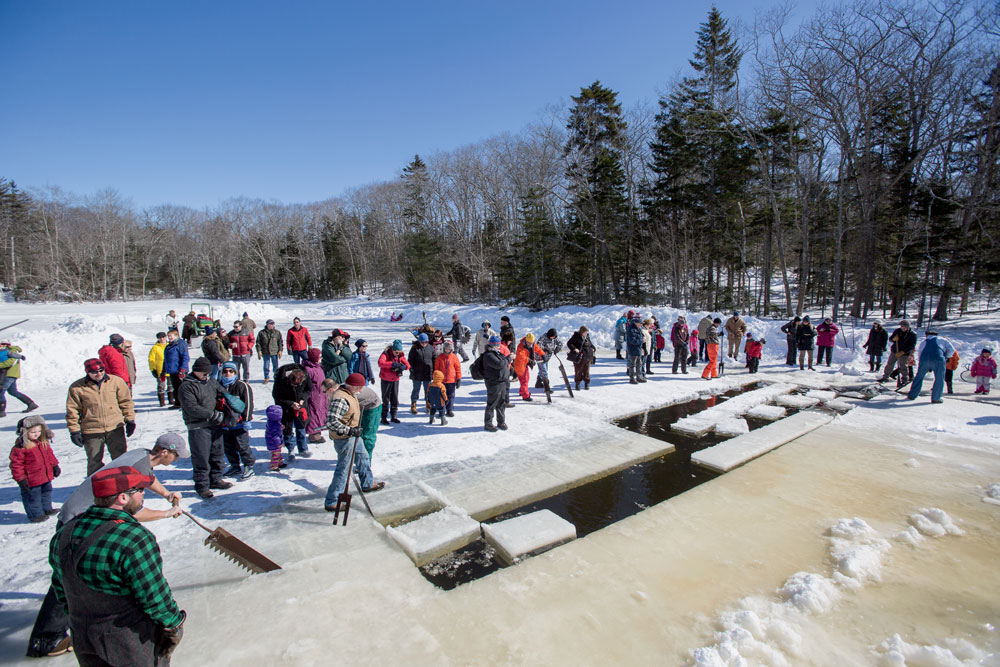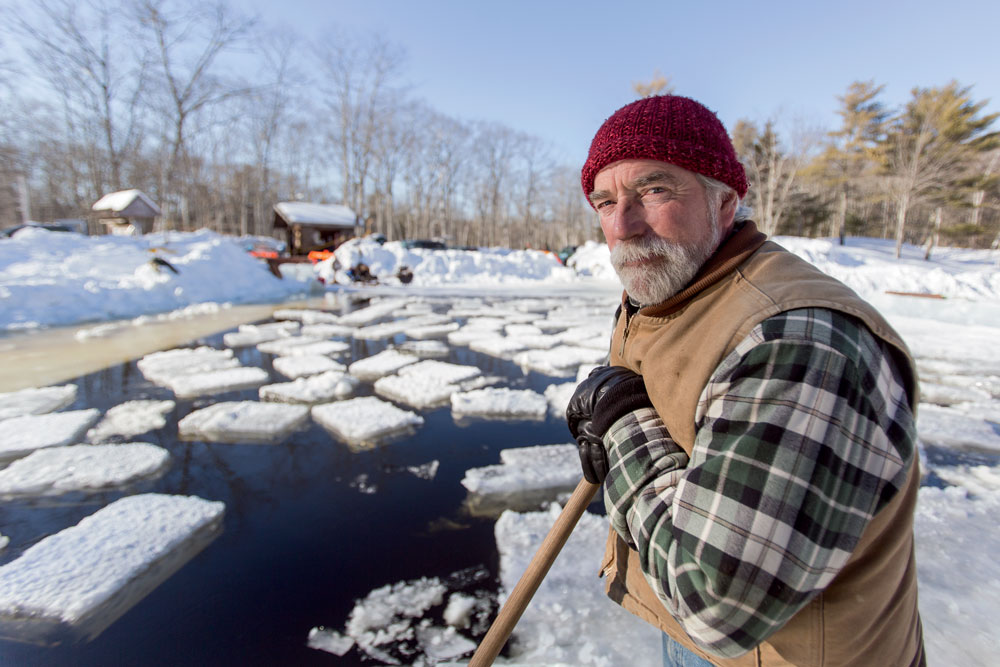Ice Harvest at the Thompson Ice House in South Bristol, Maine
Its crop is no longer making its way to the Caribbean, but at the Thompson Ice House in South Bristol, Maine, the passing of another New England winter is marked, as it has been for centuries, with an ice harvest.

Coffee By Design | Portland, Maine
Photo Credit : Katherine KeenanToday in Maine, the word “harvest” is most often associated with summer and early fall, when the state’s blueberry and potato crops come in thick and fast—but a century and a half ago, another harvest was equally valuable. Reaching its peak in the dead of winter, this crop wasn’t a grain or a fruit or a vegetable, but cold, hard ice.
In the hundred years before electricity, the same stuff that now comes out of the freezer at the touch of a button was commercially harvested directly from freshwater ponds, many of them in Maine. The resulting blocks were sent not just to neighboring homes, shops, and fishing boats, but as far away as the Caribbean and South America. With the arrival of modern refrigeration during the early 20th century, nearly all of Maine’s icehouses disappeared, but the Thompson Ice House, located on Route 129 in the Midcoast village of South Bristol, remains a rare exception.

Photo Credit : Carl Tremblay
After four generations of family ownership and nearly 160 years of commercial cutting, Herbert Thompson knew that the days of profitable ice harvesting on the pond that his great-grandfather Asa Thompson first dammed back in 1826 were over, but he couldn’t bear giving up the tradition. Fortunately, neither could many of his neighbors. After decades of fundraising, the Thompson Ice House Restoration Corporation was formed in the mid-1980s, and Thompson officially donated the house and pond for use as a working museum in 1987. From there, it took another three years to build an identical replica of the icehouse, using salvaged materials from the sagging original, complete with a small museum.
Now, each February on the Sunday of Presidents’ Day weekend, hundreds of locals (plus a smattering of new and returning visitors) turn up at the tiny wooden shack to help keep the ice harvests of South Bristol’s past an active part of its present. Despite the cold, the atmosphere crackles with animated chatter and the rasp and whine of saws. Groups of neighbors talk town news at the ice’s edge, sipping hot chocolate and munching hot dogs from the snack bar, while red-cheeked children play a game of hockey on the one-acre pond’s far side and line up for horse-drawn sleigh rides under bright winter sunshine. Steps away, the surface of the forest-ringed pond is an active work zone, and the plaid-clad volunteers manning the operation have the healthy flush to prove it.

Photo Credit : Carl Tremblay
Like most harvests, the process of getting the ice from ground to market is straightforward enough, but impossible without a liberal amount of muscle. The lion’s share of the cutting work is safely done using a sled-mounted circular saw by seasoned volunteers like Thompson Ice House president Ken Lincoln, who’s been cutting here since he was a boy. It’s fun to watch, but questions, and later a helping hand, are encouraged. It’s also a good time to pick up some ice lingo.
In South Bristol, the snow is cleared and cutting lines are marked into a pattern of blocks measuring 22 inches wide by 32 inches long. After the circular saw does its thing, the old-fashioned long saws come out—the kind with sharp, ragged teeth—and novices, including kids, are invited to try their hand at cutting, with guidance from the pros. The ice is first cut into large rafts, or “floats,” made up of the premeasured blocks. Then forked “busting bars” separate the blocks, also known as “cakes,” which float freely in the inky water like a herd of flat, rectangular icebergs. Each more than a foot thick and weighing as much as 300 pounds, the blocks move awkwardly, so workers wield long-handled “pike poles,” which look a lot like harpoons, to nudge them along toward the channel leading to the icehouse. Arriving at a wooden ramp, the blocks are met by veteran ice men wearing fluorescent, waterproof orange pants—and grins that not even the coldest Maine wind can touch. They position each block into a wooden cradle, where a pulley system (driven now by gasoline horsepower rather than the real thing) hauls it up to the icehouse, where it disappears into the storage room.
There a rugged team receives the new arrivals and uses pike poles to quickly maneuver them (well, as much as you can maneuver a hurtling 300-pound block of ice) into layers. If you can get above the operation and look down, the effect is mesmerizing: a glowing ballet of flannel-clad figures and crusted blocks of ice. To keep the shack cold, its double wooden walls are lined with nearly a foot of sawdust insulation, and hay is sandwiched between each pair of frozen layers.

Photo Credit : Carl Tremblay
The Thompson harvest serves a dual role, offering an opportunity not only to reach out and touch a chapter (or block, as it were) of Maine’s economic past, but also to bask in the warmth of honest-to-goodness community camaraderie at its hardiest. And if that’s not enough, in addition to being sold on site via the honor system, a substantial portion of the annual harvest is earmarked for use at the icehouse’s second annual event, an old-fashioned ice-cream social held each July. A bowl of hand-churned ice cream in exchange for the unique pleasure of dragging an antique saw through a foot of natural pond ice? Now, that’s pretty cool.
Thompson Ice House. Route 129, South Bristol, Maine. 207-644-8808; thompsonicehouse.com





Ice cutting has been cancelled due to snow.
Interesting factoid: “Pike Poles” is where we get our term “Turnpike”, a Pike Pole blocked cars from going ahead, but once the fee was paid, the Pike would be “Turned” (to be parallel with the road) and the car could pass. A pike is a pole, usually with points or spikes used in battle